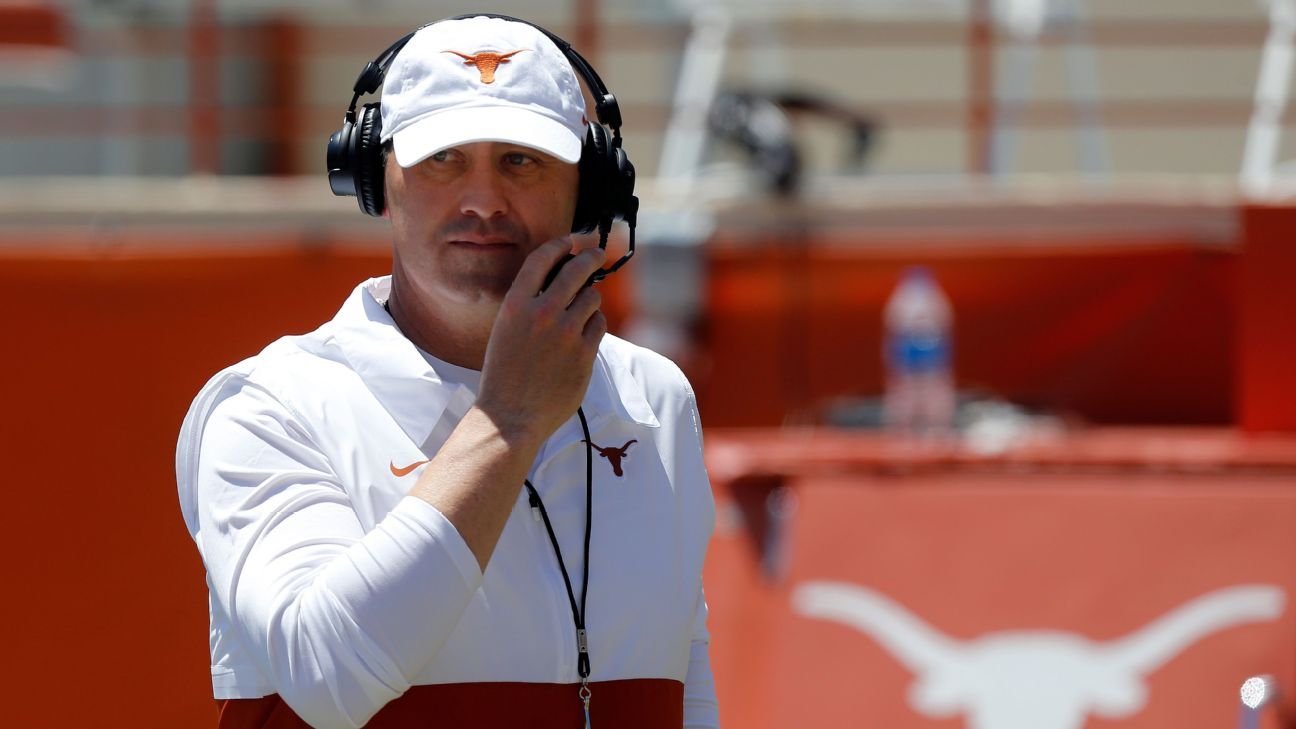Texas and Oklahoma leaving the Big 12 for the SEC could have a massive ripple effect on the college football recruiting landscape beyond the two schools themselves.
The SEC teams trying to recruit the state of Texas, the Longhorn State recruits themselves and even schools nationally will feel some change because of this decision. Whether it’s a positive or a negative, these ramifications could lead to other changes to prevent any future damages on the recruiting trail for opposing teams and conferences.
Here is a look at who will be impacted by this decision and what that impact will be going forward.

The Aggies aren’t happy about this potential move for Texas and Oklahoma, partially because they had a strategic advantage. Being the only school in Texas in the SEC allowed the coaches to pitch to recruits that they could stay in state but also play in the conference.
They could play Alabama every year and their family can come and watch them play. For Texas recruits who want to play at the highest level, that has been very attractive, and it has given Texas A&M a unique pitch.
If Texas joins the conference, Texas A&M has to share that concept, meaning its cache is thrown out the window. Any leg up in recruiting is sacred to coaches, so losing a key aspect of the appeal for a school is a big deal.
“I think the really big initial thing that I’ve thought about is one of A&M’s biggest sells, obviously in state, is the SEC over the Big 12,” an SEC personnel director said. “So, that selling point is obviously not going to be as strong. They’re still going to have that history like their first year, obviously they were doing really well, but I think with A&M, they’re going to lose that big selling point. They can fall back on Coach [Jimbo] Fisher’s success as the head coach over [Steve] Sarkisian.
“I think the sell in recruiting is going to get so much harder, just in terms of them trying to find other ways to pitch to kids.”
It also potentially hurts A&M in its pursuit of prospects in SEC states, as Texas will have a similar footprint within the conference to try to sway recruits to their school.
From 2012 to 2021, Texas A&M signed 51 prospects from SEC states, while Texas signed 32. The Aggies have a leg up on Texas right now with SEC prospects because the program has been in the conference since 2011. The Aggies have recruited top-end talent from SEC states for a while, so just because Texas would join the league doesn’t mean their pipeline would dissipate.

Texas
The Longhorns not only have an opportunity to emulate the Aggies’ pitch, but they also can sell all their recruiting targets on playing in the SEC. Recruits are aptly aware of the differences between conferences and their respective levels of success.
The Big 12 has sent one team to the College Football Playoff: Oklahoma, which has made it four times, while the rest of the league hasn’t done much else nationally.
“It would make Texas more appealing,” said David Hicks, the ninth-ranked prospect in the 2023 class, who is from Allen, Texas. “The SEC is kind of like the best where the best teams are, so it would be pretty cool.”
The Longhorns have to improve on the field, but Sarkisian is fully adept to the recruiting landscape in the SEC coming from Alabama. He has built recruiting relationships in the SEC footprint, as well as all over the country.
Sarkisian will be able to leverage those relationships now outside of the state of Texas to convince prospects to play for the Longhorns while still playing in the SEC. Some recruits in Alabama, Georgia, Florida and Louisiana — all home of premier SEC programs — want to play in that conference.
While they might like the offense Sarkisian runs, if Texas stays in the Big 12, it might be less appealing to them. With Texas in the SEC, that pitch to recruits in southern states has the opportunity to resonate to try to get them to Austin, Texas.
Sarkisian has already leveraged his relationships in California, securing a commitment from ESPN 300 quarterback Maalik Murphy. Sarkisian was a big factor in Alabama signing quarterback Bryce Young, the No. 1 quarterback in the 2020 class, from California, as well.
Giving the Texas coaching staff any more leverage in those areas than they already have could prove bountiful on the recruiting trail for the Longhorns.

Oklahoma
As much sense as the move makes for Texas, it doesn’t make as much sense for Oklahoma, outside of the money and the fact the Sooners wouldn’t want to stay in the Big 12 without Texas.
The Sooners are already recruiting at a high level, have made the playoff four times, have an apparel relationship with the Jordan brand and have high-end coaches.
Over the past six recruiting classes, Oklahoma has signed high school prospects from 21 different states, six of which have been in the SEC footprint. The coaches have signed the 11th-most ESPN 300 prospects over the past five recruiting classes and are basically hand-picking which quarterback they want in each class.
Riley signed Spencer Rattler, the No. 1 dual-threat quarterback in 2019, out of Arizona; signed Caleb Williams, the No. 1 dual-threat quarterback from Washington, D.C., in 2021; and now have a commitment from Malachi Nelson, the No. 17 overall recruit in the 2023 class, from California.
The coaches have also bolstered their defense under coordinator Alex Grinch, getting commitments from 24 defensive prospects ranked as four stars or better in the past four recruiting cycles.
In addition to those numbers, the staff has signed 22 ESPN 300 recruits from Texas from 2017 to 2021. Of the 22 they signed, 18 were offensive players, including wide receivers CeeDee Lamb and Theo Wease.
Does joining the SEC help Oklahoma in its pursuit of prospects from Texas, or does it hurt those chances? On one hand, recruits want to play in an explosive offense, and now they can do that at Oklahoma while competing in the SEC.
1:54
Stephen A. Smith explains why Texas and Oklahoma joining the SEC is great for the conference, but would be awful for the rest of college football.
“I think if they add Texas and Oklahoma, I think, Oklahoma’s sell for trying to get kids out of Texas, it’s going be so much harder,” an SEC personnel director said. “If you want to come here and play for the SEC, well I have two schools now that are much closer. Maybe it’ll just expand their recruiting footprint, maybe they try and go west, or north or something and try and pitch to some other states that they’re closer to come play for the SEC at a closer school than having to jump all the way down to Texas A&M or having to jump to LSU.”
On the other hand, with Sarkisian having the same opportunity to sell the SEC, does that make it easier for Texas prospects to stay home and pick the Longhorns or Aggies? Also, in turn, the Sooners will now have more competition in the state of Texas, as other SEC schools are going to lure top recruits away from them.

SEC schools
Alabama went into Texas in the 2021 class to raid the state of its top players. The No. 1 recruit in Texas (and the No. 2 prospect overall), offensive tackle Tommy Brockermeyer, committed with his ESPN 300 brother, James, to Alabama.
The Crimson Tide signed seven ESPN 300 recruits from Texas in 2021 and are probably licking their chops at the thought of adding Texas to the conference.
While Texas A&M has told recruits they can play in the SEC and stay home, Alabama has told recruits in Texas that they can come to Tuscaloosa, play in the SEC and go home every other year when they play against Texas A&M.
Depending on how alignment works out, if Texas is on Alabama’s schedule regularly, it’s double the recruiting pitch and double the opportunity for Alabama to sell that Texas recruits can still play close to home.
“If they have twice the chances to come back to Texas to play in front of their families, I think that’s definitely appealing, and I think LSU, too, could even make it a hit just because of them being right there,” an SEC personnel director said. “It’ll be interesting to see if that’s a pitch people go with. I don’t know if the East teams are really going to get much effected before the conference alignment comes out, because you have Bama and LSU. If they can take that pitch of how close it’s going to be to play more games, for Texas kids going back home, potentially multiple times a year, it could work.”
LSU signed 13 recruits from Texas from 2017 to 2021, and the staff would love to have another pitch in their pocket to land more. Not every other SEC school has had as much success as Alabama and LSU in Texas, but others have tried.
Georgia has signed four ESPN 300 recruits in the same timespan, while Auburn, Arkansas, Florida and Mississippi State have all signed three each.
Those numbers don’t mean the schools wouldn’t like to get into Texas, though, and with another school in the SEC, it might allow some of the schools outside of LSU and Alabama in the conference to up their numbers in the state.
1:16
Sam Acho is confident Texas and Oklahoma will have no problem being strong competitors in the SEC.

The Buckeyes have done a good job recruiting the state of Texas under head coach Ryan Day, adding seven ESPN 300 recruits from Texas since he took over in 2019. That includes wide receiver Garrett Wilson and the No. 2 overall prospect in the 2022 class, quarterback Quinn Ewers, who won’t sign his national letter of intent until December.
This cycle of conference realignment is all still fresh, so when asked how this could impact his school, Day wasn’t sure what the true impact would be, if any.
“In the end, the schools are still the schools and the resources that they provide are the resources that they provide,” Day said. “You know, we should be in the national championship picture every year, so that won’t change. So having two more teams in a conference, how will that affect the other conferences? I don’t know.”
The impact should be minimal for a team such as Ohio State. Ohio State’s offense has been explosive under Day, and the Buckeyes have reached the playoff in back-to-back seasons. As Day said, that doesn’t change with Texas and Oklahoma joining the SEC. And if the coaching staff was already able to pull those prospects up to Ohio, that shouldn’t change, either.

The rest of the Big 12
Outside of Texas and Oklahoma, the other Big 12 teams have not recruited at a high level in recent years. Over the past five recruiting classes, the Big 12 as a conference has added 162 ESPN 300 recruits, fewest among the Power 5.
Texas and Oklahoma have accounted for 113 of the 162 top-300 recruits in the conference. Removing those two schools from the Big 12 leaves a giant gap in what the recruiting landscape could look like and puts a dent in the rest of the conference for future recruiting, as well.
Prospects want to play at a high level, and if the two biggest programs in the conference are gone, what are the elite-level recruits going to think of the other programs still in the conference?
If the Big 12 doesn’t add any big names, or, even worse, loses more teams to other conferences, it will be devastating to the rest of the teams from a recruiting standpoint because there wouldn’t be a big sell for top-end talent to play in the conference.
